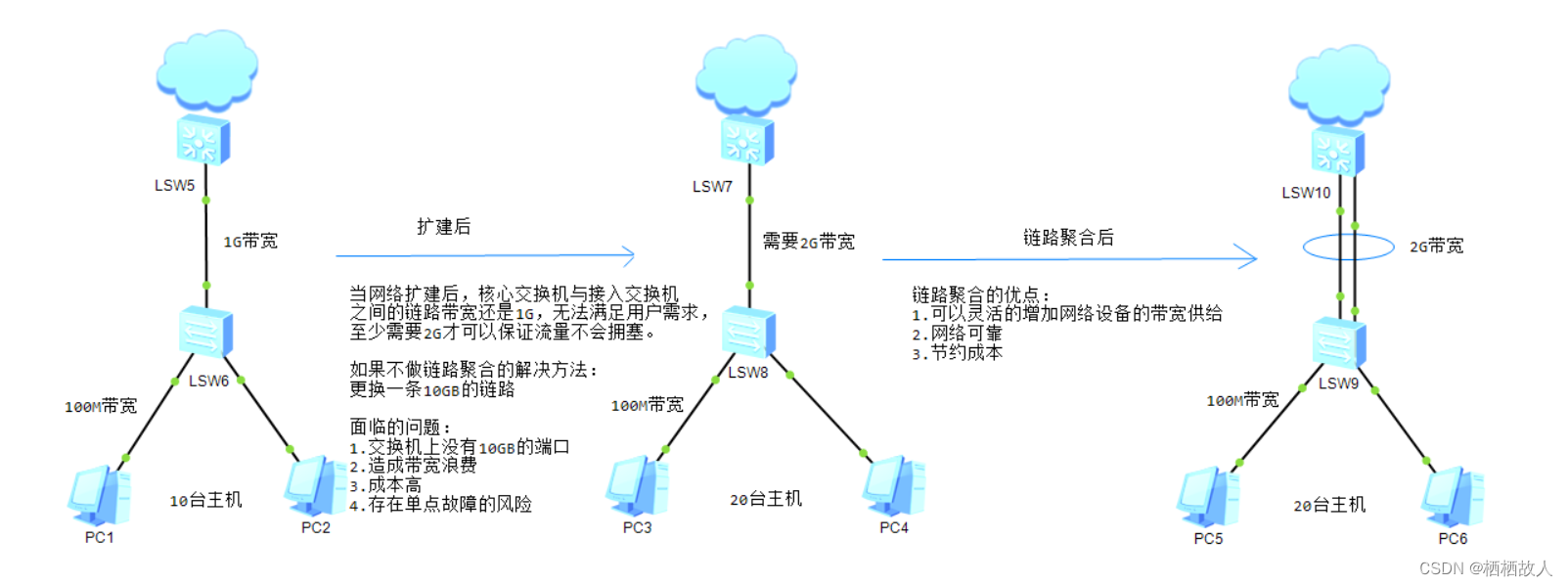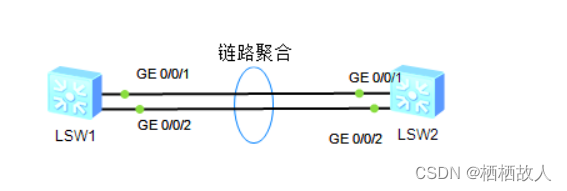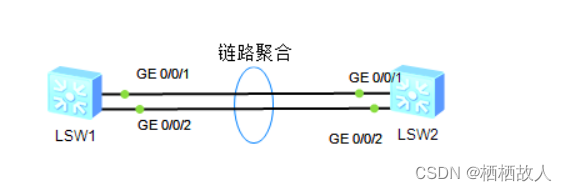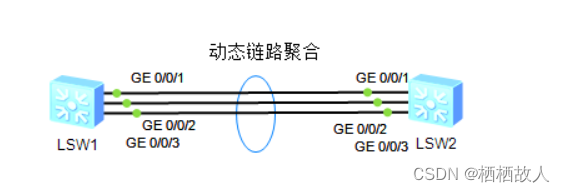目录
一.为什么要做链路聚合?
二.华为:Eth-Trunk
(1)配置手动模式(静态)
1.基本配置
2.物理接口配置
3.配置ETH-Trunk的链路类型
4.查看Eth-Trunk12链路
5.在加入端口前必须要移除物理端口配置
2.配置动态LACP
1.基本配置
2.配置ETH-Trunk的链路类型
3.配置优先级
4.查看Eth-Trunk 3链路
5.应用场景
三.思科Port-channel
1.静态on
基础配置
2.动态(不能两边都是被动)
(1)LACP公有:
(2)PACP私有:
3.查看链路聚合
一.为什么要做链路聚合?

(1)当网络扩建后,核心交换机与接入交换机之间的链路带宽还是1G,无法满足用户需求,至少需要2G才可以保证流量不会拥塞。
如果不做链路聚合的解决方法:
更换一条10GB的链路
面临的问题:
1.交换机上没有10GB的端口
2.造成带宽浪费
3.成本高
4.存在单点故障的风险
(2)链路聚合的优点:
1.可以灵活的增加网络设备的带宽供给
2.网络可靠
3.节约成本
二.华为:Eth-Trunk
(1)配置手动模式(静态)


1.基本配置
[S1]interface Eth-Trunk 12
[S1-Eth-Trunk12]mode manual load-balance// 默认此模式,所以可以省略此配置
2.物理接口配置
在物理接口加入:
[S1]interface GigabitEthernet 0/0/1
[S1-GigabitEthernet0/0/1]eth-trunk 12
在虚拟接口加入:
[S1]interface Eth-Trunk 12
[S1-Eth-Trunk12]trunkport g0/0/2
统一加入:
[S1]interface Eth-Trunk 12
[S1-Eth-Trunk12]trunkport GigabitEthernet 0/0/1 to 0/0/2
3.配置ETH-Trunk的链路类型
[S1-Eth-Trunk12]port link-type trunk
[S1-Eth-Trunk12]port trunk allow-pass vlan all
4.查看Eth-Trunk12链路
[S1]display eth-trunk 12
Eth-Trunk12's state information is:
WorkingMode: NORMAL Hash arithmetic: According to SIP-XOR-DIP
Least Active-linknumber: 1 Max Bandwidth-affected-linknumber: 8
Operate status: up Number Of Up Port In Trunk: 2
--------------------------------------------------------------------------------
PortName Status Weight
GigabitEthernet0/0/1 Up 1
GigabitEthernet0/0/2 Up 1
英文注解:
Least Active-linknumber 最小活动链接号
Max Bandwidth-affected-linknumber 受最大带宽影响的链接号
注意:静态聚合只会在乎自己的接口是否UP,只要加入物理端口就可以开始工作,有环路风险,而动态不同,动态要进行协商。如果动态起不来,再做静态。
类比记忆:动态就是温柔劝导,静态是强行加入。
5.在加入端口前必须要移除物理端口配置
否则无法加入端口,并且报错
Error: Failed to add the port into the trunk because the port has been a member of the trunk.
错误:无法将端口添加到trunk中,因为该端口已是一类trunk
2.配置动态LACP

1.基本配置
[S2]interface Eth-Trunk 3
[S2-Eth-Trunk3]mode lacp-static //模式为动态LACP
[S2-Eth-Trunk3]max active-linknumber 2 //配置最大活跃端口为2
加入物理端口:
[S2]interface g0/0/1
[S2-GigabitEthernet0/0/1]eth-trunk 3
加入虚拟端口:
[S2-GigabitEthernet0/0/1]eth-trunk 3
[S2-Eth-Trunk3]trunkport g0/0/2
统一加入:
[S2]interface Eth-Trunk 3
[S2-Eth-Trunk3]trunkport GigabitEthernet 0/0/1 to 0/0/3
如果聚合需要改动模式,需要去除加入的物理接口后改变模式
2.配置ETH-Trunk的链路类型
[S2-Eth-Trunk3]port link-type trunk
[S2-Eth-Trunk3]port trunk allow-pass vlan all
3.配置优先级
使得SW2成为主动端
[S2]lacp priority 30000
4.查看Eth-Trunk 3链路

5.应用场景
路由器与交换机之间
交换机与交换机之间
服务器与服务器之间
路由器与路由器之间
三.思科Port-channel
1.静态on
基础配置
interface range e0/3 ,e0/2
SW1(config-if-range)#channel-group 14 mode on
SW1(config)#interface port-channel 14
SW1(config-if)#switchport trunk encapsulation dot1q
SW1(config-if)#switchport mode trunk
2.动态(不能两边都是被动)
(1)LACP公有:
LACP状态:active 主动 passive 被动
基础配置:
SW1(config)#interface range e0/2,e0/3
SW1(config-if-range)#channel-group 14 mode active
(2)PACP私有:
PACP状态:desirable 主动 auto 被动
基础配置:
SW1(config)#interface range e0/2,e0/3
SW1(config-if-range)#channel-group 14 mode desirable
3.查看链路聚合
Switch#show etherchannel
*Nov 30 12:50:20.788: %LINEPROTO-5-UPDOWN: Line protocol on Interface Port-channel14, changed state to up
Switch#show etherchannel s
Switch#show etherchannel summary
Flags: D - down P - bundled in port-channel
I - stand-alone s - suspended
H - Hot-standby (LACP only)
R - Layer3 S - Layer2
U - in use N - not in use, no aggregation
f - failed to allocate aggregator
M - not in use, minimum links not met
m - not in use, port not aggregated due to minimum links not met
u - unsuitable for bundling
w - waiting to be aggregated
d - default port
A - formed by Auto LAG
Number of channel-groups in use: 1
Number of aggregators: 1
Group Port-channel Protocol Ports
------+-------------+-----------+-----------------------------------------------
14 Po14(SU) LACP Et0/0(P) Et0/1(P)






